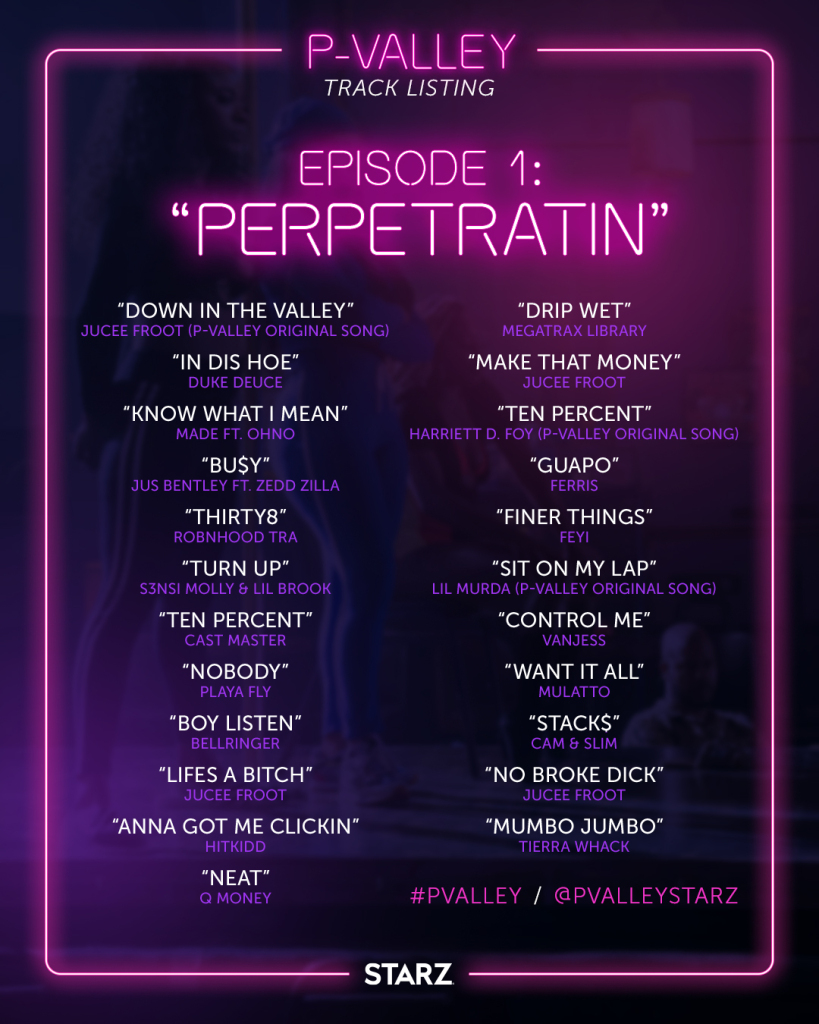How Music Supervisors Helped ‘P-Valley’ Achieve Hip-Hop Parity With 50% Female Soundtrack – Variety

Gender parity was foremost on the mind of “P-Valley” creator Katori Hall whose goal was not only to have women onscreen but also behind the scenes (Hall, of “Tina the Musical” fame, hired two female casting directors, two female editors, four female DPs and eight women to direct the series) and on the hip hop-heavy soundtrack, which features 50% female artists.
The new drama, premiering on Starz tonight (July 12) is adapted from Hall’s play, “Pussy Valley,” and revolves around a strip club called Pynk. Set in the Mississippi Delta, the women working as exotic dancers are trying to get out of the club and the shackles of fictional town, Chucalissa.
Hall called in music supervisors Stephanie Diaz-Matos (“The Get Down”) and Sarah Bromberg (“Pitch Perfect 2”) to set the tone for the show. The two talk to Variety about looking to artists like City Girls and Megan Thee Stallion to deliver the pumping sounds of striptease.
What were some of the first conversations you had about the music for the show?
Stephanie Diaz-Matos: The first thing Katori said from our first meeting to the final mix was that she wanted the music to be authentic. She wanted it to feel real to the strip club world, to Memphis and the South. And she wanted a mix of classics and new material. Katori is such an avid music listener and she was very concerned about the timeliness of the music and making sure we had new stuff for when the show came out, but to also play classics that were club hits.
Sarah Bromberg: Spotify has a playlist called, “Dirty South,” and that was a big departure point for us. There would be producers, and it was like following the breadcrumbs. We like this person and it’s produced by this person and then they also produce that and maybe they have female artists.
Tell us about the incredible female artists that you brought in. How did you choose who was right for the show?
Bromberg: The idea was to use female voices, especially when the girls were dancing. There was an incredible amount of needle drops in the first two episodes. It was about finding enough artists that were from the correct areas. We sent out searches for female artists. We scoured around and we made so many playlists putting together every song that might work and it was a challenge to fill all the spots. We found some amazing artists and we also commissioned new pieces.
One of those commissioned works was “Trinity” in episode three by Tokyo Vanity. How did that come about?
Diaz-Matos: That was an artist that Katori had to have. We tracked them down and they submitted a few ideas. I think the one that we landed with works perfectly. But we shot to it, choreographed to it and edited to it, and it worked out. Jucee Froot was someone else Katori latched on to for music who created original songs for us.
At what stage did you bring Megan Thee Stallion into the mix, because her currency has certainly gone up in the last year, and one would imagine so has the rate to use her songs.
Bromberg: She was on top of our list from the very start because she was just exploding on the scene, and she was made a priority for sure. We used a song that played early in a cut and a must-have for Katori. It was a journey and a struggle to properly clear her music. It was like that for many artists on the show. We pitched her for tons of spots. There were two that placed and another one we loved, but it had to drop out because we couldn’t fully clear it and there were some issues on the publishing side.
Since the show is music heavy, how did you strike the balance of where to use the music and where to give the audience a break?
Bromberg: I don’t think there’s a lot of quiet time in the show, but there are very smart musical gearshifts that provide the breaks. It really comes down to the storytelling. When you have a showrunner as Katori, she’s not afraid to flip the script where it’s an opportunity to look at the story differently and tell a different way and you’re going to drop like something different like Valerie June.
Did you do much vocal matching with the characters such as using Tokyo Vanity for Mercedes or Valerie June for Keyshawn (Shannon Thornton)?
Diaz-Matos: There were a lot of conversations that happened when we were exploring the main title, which the main title was a very long process. But through that, when we were listening to voices, we’d have conversations saying, ‘This sounds like that character.’

Starz